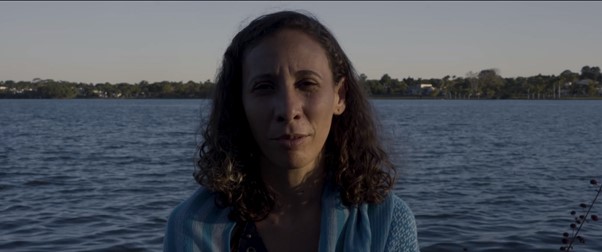Colmeia (2021) unravels marked by a constant sensation of disintegration; Huri narrates her violent story candidly in her peaceful voice. The character’s conversation with Maurício, staged as spontaneous, is really pre-rehearsed. She confides that this is the first time that she will relate her crime, but the way she speaks, conjugating the verbs in the imperfect, like someone re-telling a dream, provoke the sensation that the events of her life are really a fable which has already been repeated many times.
These antitheses are also implicated in the image: sitting in front of a lake, Huri is illuminated by refluxed light reflecting the water’s light onto her skin. The informality of her conversation with Maurício contrasts with the meticulous photographic construction, which centralises the character on the screen, looking straight into the camera, creating a symmetrical design. These contradictions are followed through in the film, which creates a continuity in these incompatibilities.
The unfolding of these mirror images and discontinuities are also contained in the character: Pamela’s story and her fragments live on in Huri, opposing elements occupying the same body. Her past repeats and stumbles into her present; Pamela will kill to defend herself from abuse and is abused in her penitence. Reflections, which reproduce and diverge, like a mirror that shows a similar but paradoxically inverse image on the other side.
When Huri ends her story, the film seeks other images, encountering the lake that surrounds it; Huri throws Pamela’s fingernails into the water, as though in a farewell ritual – now she is part of the river. Her past no longer belongs to her; rather it is part of a collective social injustice. In Huri’s card readings the world is ending and in order that a new one can be created everyone must return to madness, or the skies will fall on our heads.
In the final moments, fiery explosions burst from the still waters of the river and the whole naturalistic scenario is broken up with computer graphics. The scene becomes dreamlike: Huri dreams that the rising waters will cause destruction and, just like the CGI fire, launch explosions in an impassive and disinterested world, which follows its path indifferent to pain. The houses catch fire, but do not burn down. Tomorrow they will still be standing as though flames never touched them.
Manu Zilveti

